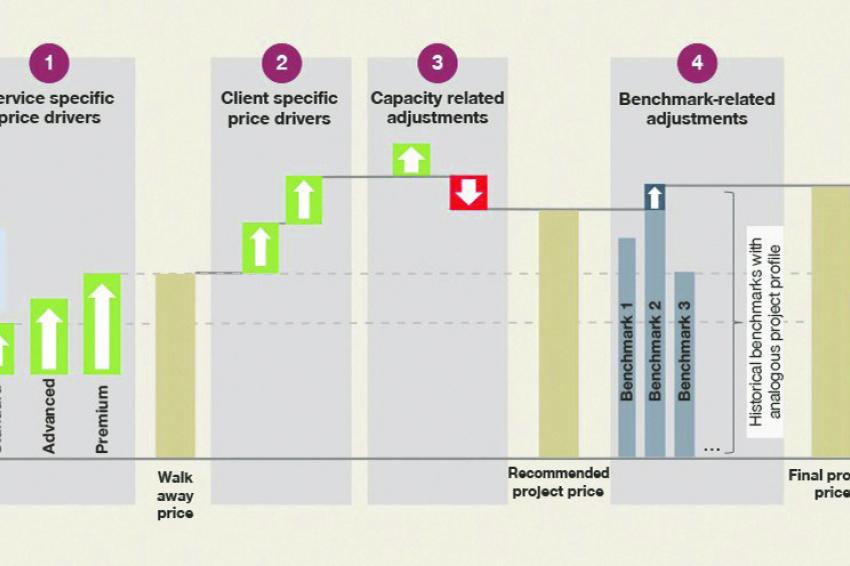Markets & Companies
Why CDMOs Should Consider Value-Based Pricing
CDMOs Need to Continuously Optimize their Commercial Strategy
Outsourcing product development and manufacturing has become for many pharmaceutical and biotech companies a strategic activity and an integral part of their business model. In order to capitalize on this trend, contract development and manufacturing organizations (CDMOs) need to continuously optimize their commercial strategy by establishing and enforcing a value-based pricing concept.
The pharmaceutical industry continues to grow and is estimated to be worth $1.5 trillion by 2021. One important element of this development: the accelerating trend towards outsourcing product development and manufacturing to CDMOs. What sounds like good news for CDMOs also holds its own challenges — many CDMOs are operating in a highly fragmented market that is currently undergoing a significant consolidation. At the same time, many of them are not fully prepared to exploit the maximum potential and willingness-to-pay in project pricing. This calls for new and innovative monetization strategies, with the right approach to project pricing as a vital element. Price is the single most powerful lever to increase a company’s profits. However, right now, far too many companies are still clinging to traditional cost-plus pricing logics that usually lack consistency, transparency and control and in most cases are set based on a pre-determined self-fulling margin target. This approach needs to be replaced by harmonized costing methodologies, value-based pricing metrics, and systematic usage of internal project price benchmarks. These three areas will enable CDMOs to develop a value-based price model that fully exploits price potential and monetizes willingness-to-pay.
Pricing-Related Commercial Challenges of CDMOs
Based on our project experience, we observe a number of typical pricing issues at CDMOs:
Costing: Use Local Cost Levels Following a Globally Aligned Consistent Logic
No two projects are alike, so costs as well as client needs differ greatly. To standardize project costing, companies have to develop guidelines, tools, and processes on top or replacing site policies. This enables site managers to make their own decisions, but within a certain framework, following a company-wide costing logic and granularity. The first fundamental step is to enable every site to assess costs realistically based on a consistent guiding principle. Striking a common balance on the level of cost granularity applied enables different sites to calculate costs coherently on a per service element.
Value-based Pricing: Capture Project-specific - Value Drivers to Extract - Willingness to Pay
CDMOs then have to identify all relevant value and price drivers as well as their magnitude to apply to the cost base per service element. The problem: They often lack reliable data input. Market research data is not available since projects are unique and the pharma industry is considerably small. Testing CDMOs’ customers’ value perception and willingness to pay in the same way other industries are able to do so is not easy. Consequently, companies need to work with experts and proxies to determine clients’ perception of value. After determining these value and price drivers (e.g. type of drug potential, client time pressure, reliability risk, commercial price potential of drug, site capacity), they are subsequently translated into quantifiable margin mark-ups or -downs. Best-in-class CDMOs even categorize their services according to the level of differentiation vs. competition and apply differentiated value mark-ups instead of always applying the same one across the board. Combined with price benchmarks, CDMOs can now move away from gut feelings and ensure that price variations between similar contracts and customers are narrow.
Benchmarking: Providing Historical Transparency for Pricing Managers
Right now, most CDMOs don’t have any system at all that documents project pricing. The result: inconsistent pricing for similar services. This backfires if it happens with the same customer leading to unnecessary irritation and frustration. A database containing historical project information for both won and lost deals provides an antidote and serves as valuable pricing decision support information. In here, every project is registered and sorted based on predefined criteria so that the information can be easily pulled for future pricing decisions. This is especially vital since CDMO projects vary widely which requires that useful benchmarks contain a high level of “definition” granularity. A central system which collects, documents as well as incorporates and institutionalizes price benchmarks will provide pricing mangers the overview to make optimal pricing decisions.
Implementation through Clever Pricing Tools To ensure CDMOs use a consistent pricing approach, they not only have to develop the value-based pricing metric but also define the processes to use it. A simple solution is to develop an easy-to-use pricing tool that harmonizes costing methodologies and uses value-based pricing methods as well as newly defined benchmarks to support quotes. Such a customized pricing tool allows projects to be configured and priced in a structured way. Along with a systematic project pricing logic — based on value-based mark-ups/downs — this significantly increases the chances for CDMOs to best exploit customer willingness to pay and negotiate optimal prices. In doing so the reward can be significant and from our experience: CDMOs are usually able to improve their margin and profitability by three to six percent return on sales.
The pharmaceutical industry continues to grow and is estimated to be worth $1.5 trillion by 2021. One important element of this development: the accelerating trend towards outsourcing product development and manufacturing to CDMOs. What sounds like good news for CDMOs also holds its own challenges — many CDMOs are operating in a highly fragmented market that is currently undergoing a significant consolidation. At the same time, many of them are not fully prepared to exploit the maximum potential and willingness-to-pay in project pricing. This calls for new and innovative monetization strategies, with the right approach to project pricing as a vital element. Price is the single most powerful lever to increase a company’s profits. However, right now, far too many companies are still clinging to traditional cost-plus pricing logics that usually lack consistency, transparency and control and in most cases are set based on a pre-determined self-fulling margin target. This approach needs to be replaced by harmonized costing methodologies, value-based pricing metrics, and systematic usage of internal project price benchmarks. These three areas will enable CDMOs to develop a value-based price model that fully exploits price potential and monetizes willingness-to-pay.
Pricing-Related Commercial Challenges of CDMOs
Based on our project experience, we observe a number of typical pricing issues at CDMOs:
- Non-transparent costing: For CDMOs, every project is different, and costs depend on countless variables. Consequently, determining the full costing is essential to make sure that companies operate profitably. However, in many cases managing directors of individual sites manage their own profit and loss statements and often exert their will for project scoping and costing. In this context, the way costs are calculated and reported can differ based won site-specific preferences and legacy. This leads to costing of projects often becoming a black box to central commercial CDMO functions as sites use different cost calculation methodologies and level of granularity.
- No value-based pricing: Pricing is short-term, cost-plus and silo focused; CDMOs do not systematically exploit differentiated margins based on client value or strategic service elements. What we see is that CDMOs often apply a standard site-specific mark-up on their costing without considering the value of individual services and as such simply apply a one-size fits all approach. Some services might be standard, others unique and should ideally call for a higher or differentiated mark-up.
- Insufficient pricing benchmarks and intelligence: The limited availability of historic project benchmarks and post-deal profitability analysis prevents clever and consistent pricing decisions. Since project specificities and prices are not documented systematically, business development managers often don’t have full visibility on past projects and their pricing for recurring clients. This gets even more challenging if a CDMO has a global footprint and customers have several touchpoints within the company. The full value of a client is not understood and the CDMO’s negotiating position is considerably weakened.
Costing: Use Local Cost Levels Following a Globally Aligned Consistent Logic
No two projects are alike, so costs as well as client needs differ greatly. To standardize project costing, companies have to develop guidelines, tools, and processes on top or replacing site policies. This enables site managers to make their own decisions, but within a certain framework, following a company-wide costing logic and granularity. The first fundamental step is to enable every site to assess costs realistically based on a consistent guiding principle. Striking a common balance on the level of cost granularity applied enables different sites to calculate costs coherently on a per service element.
Value-based Pricing: Capture Project-specific - Value Drivers to Extract - Willingness to Pay
CDMOs then have to identify all relevant value and price drivers as well as their magnitude to apply to the cost base per service element. The problem: They often lack reliable data input. Market research data is not available since projects are unique and the pharma industry is considerably small. Testing CDMOs’ customers’ value perception and willingness to pay in the same way other industries are able to do so is not easy. Consequently, companies need to work with experts and proxies to determine clients’ perception of value. After determining these value and price drivers (e.g. type of drug potential, client time pressure, reliability risk, commercial price potential of drug, site capacity), they are subsequently translated into quantifiable margin mark-ups or -downs. Best-in-class CDMOs even categorize their services according to the level of differentiation vs. competition and apply differentiated value mark-ups instead of always applying the same one across the board. Combined with price benchmarks, CDMOs can now move away from gut feelings and ensure that price variations between similar contracts and customers are narrow.
Benchmarking: Providing Historical Transparency for Pricing Managers
Right now, most CDMOs don’t have any system at all that documents project pricing. The result: inconsistent pricing for similar services. This backfires if it happens with the same customer leading to unnecessary irritation and frustration. A database containing historical project information for both won and lost deals provides an antidote and serves as valuable pricing decision support information. In here, every project is registered and sorted based on predefined criteria so that the information can be easily pulled for future pricing decisions. This is especially vital since CDMO projects vary widely which requires that useful benchmarks contain a high level of “definition” granularity. A central system which collects, documents as well as incorporates and institutionalizes price benchmarks will provide pricing mangers the overview to make optimal pricing decisions.
Implementation through Clever Pricing Tools To ensure CDMOs use a consistent pricing approach, they not only have to develop the value-based pricing metric but also define the processes to use it. A simple solution is to develop an easy-to-use pricing tool that harmonizes costing methodologies and uses value-based pricing methods as well as newly defined benchmarks to support quotes. Such a customized pricing tool allows projects to be configured and priced in a structured way. Along with a systematic project pricing logic — based on value-based mark-ups/downs — this significantly increases the chances for CDMOs to best exploit customer willingness to pay and negotiate optimal prices. In doing so the reward can be significant and from our experience: CDMOs are usually able to improve their margin and profitability by three to six percent return on sales.











